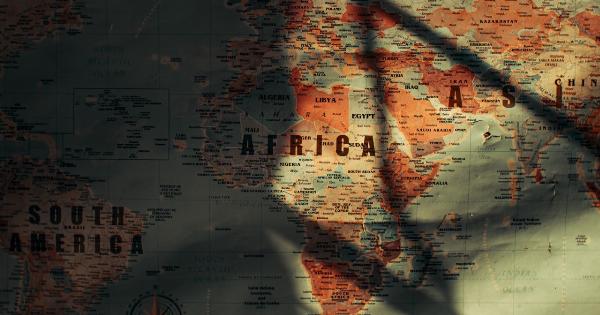The Ebola virus disease (EVD), formerly known as Ebola hemorrhagic fever, is a severe and often fatal illness caused by the Ebola virus. It is transmitted to humans from wild animals and then spreads through human-to-human transmission.
This deadly disease first appeared in 1976 in two simultaneous outbreaks, one in Sudan and the other in Zaire (now the Democratic Republic of Congo). Since then, numerous outbreaks of Ebola have occurred, causing widespread fear and devastation.
The Origins of Ebola
The exact origins of Ebola are still uncertain, but it is believed to have originated from fruit bats, which carry the virus without being affected by it.
The virus is then passed on to other animals, such as monkeys and antelope, that come into contact with the bats, leading to potential transmission to humans through hunting, handling, or consuming infected wildlife.
The Symptoms and Progression of Ebola
Once a human is infected with the Ebola virus, the symptoms typically appear within 2 to 21 days. The initial symptoms mimic those of common illnesses, making it difficult to diagnose initially.
These symptoms include fever, headache, muscle pain, fatigue, and sore throat.
As the virus progresses, more severe symptoms emerge, including vomiting, diarrhea (often with blood), rash, impaired kidney and liver function, and in some cases, internal and external bleeding.
Ebola attacks multiple organ systems in the body, leading to systemic dysfunction and, ultimately, death in many cases.
The Devastating Impact of Ebola
Over the past few decades, several major outbreaks of Ebola have occurred in different parts of Africa, causing widespread panic and devastation.
One of the most severe outbreaks occurred from 2014 to 2016 in West Africa, primarily affecting Guinea, Liberia, and Sierra Leone.
The World Health Organization (WHO) declared it a Public Health Emergency of International Concern as the disease rapidly spread and overwhelmed the healthcare systems in these countries.
The outbreak resulted in over 11,000 deaths and left many families and communities shattered.
The Heroes in the Fight Against Ebola
In the face of this terrifying disease, numerous healthcare workers and volunteers have stepped forward as the true heroes in the fight against Ebola.
These brave individuals risk their lives to care for those infected and work tirelessly to contain the virus.
Medical personnel from around the world have traveled to affected regions, providing crucial support and resources.
They wear extensive protective gear to reduce the risk of contracting the virus themselves but continue to provide care and comfort to those in need.
Furthermore, local healthcare workers in affected communities have played a crucial role in raising awareness, educating the public about prevention measures, and providing immediate medical assistance to those showing symptoms.
The Impact on Communities and Daily Life
The devastating effects of Ebola extend far beyond the immediate health consequences. Entire communities suffer from the stigma associated with the disease, leading to social isolation and economic decline.
School closures, travel restrictions, and limitations on public gatherings become necessary to contain the virus, disrupting the daily life of millions. Markets close, jobs are lost, and families struggle to put food on the table.
The long-lasting impact of Ebola on these communities is often overlooked, but it is a significant aspect that should not be forgotten.
Photographic Perspective on the Horror
Photographs have the power to capture the essence of a moment and convey emotions that words alone cannot fully describe. In the case of Ebola, powerful images have documented the horrors and devastation caused by this deadly disease.
Through the lens, we see the fear in the eyes of the infected, the grief of losing loved ones, and the tireless efforts of healthcare workers.
These photographs serve as a stark reminder of the urgent need to find effective treatments, prevent future outbreaks, and support the affected communities.
The Importance of Public Awareness and Preparedness
Preventing and controlling future outbreaks of Ebola requires a collective effort from governments, healthcare organizations, and the public.
Public awareness campaigns play a crucial role in informing individuals about the disease, its transmission, and prevention strategies.
Access to accurate and reliable information is paramount in dispelling myths and misconceptions surrounding Ebola. By understanding the risks and adopting preventive measures, individuals can protect themselves and their communities.
Furthermore, global collaboration and investment in research are essential for the development of effective vaccines, treatments, and diagnostic tools.
Adequate funding must be allocated to support these efforts and ensure preparedness in the face of future outbreaks.
Rebuilding Lives and Communities
While the horrors of Ebola may seem like a nightmare from a distant past for some, the affected communities continue to grapple with the aftermath. Rebuilding lives and communities takes time, resources, and support from the international community.
Efforts should focus not only on improving healthcare systems but also on addressing the long-term social, economic, and psychological impacts.
Education, vocational training programs, and economic opportunities can help affected individuals and communities regain their self-sufficiency and rebuild their lives.
The Need for Continued Vigilance
Although the media attention surrounding Ebola has waned in recent years, the risk of future outbreaks remains. The Ebola virus persists in animal reservoirs, and the potential for cross-species transmission to humans is a constant concern.
While progress has been made in developing vaccines and treatments, ongoing research and preparedness efforts should not be neglected.
The devastating consequences of past outbreaks serve as a testament to the need for eternal vigilance in the face of this deadly virus.
























